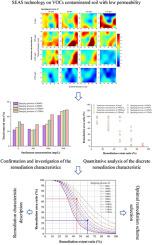Journal of Contaminant Hydrology ( IF 3.6 ) Pub Date : 2022-07-07 , DOI: 10.1016/j.jconhyd.2022.104049 Long Xu 1 , Lixue Yan 1 , Fusheng Zha 1 , Fanghua Zhu 1 , Xiaohui Tan 1 , Bo Kang 1 , Chengbin Yang 1 , Zhiyue Lin 2

|
Surfactant-enhanced air sparging (SEAS) is an effective technology for the remediation of volatile organic compounds contamination of medium and high-permeability soil, though applying SEAS to low-permeability soil contamination has rarely been explored. In this study, a series of two-dimensional physical model tests were designed to explore the feasibility and remediation characteristics of SEAS on low-permeability soil. In the test results, the incorporation and increase in surfactant concentration promoted air channel formation in the low-permeability soil, finally reduced the capillary breakthrough pressure and improved the airflow rate. The majority of the exhausted gaseous contaminants were distributed along the horizontal direction, differing from the results observed in medium and high-permeability soils. The exhausted gaseous contaminant concentration changed slightly when the sparging pressure and surfactant concentration increased at relatively low levels and increased as the sparging pressure and surfactant concentration increased further. Increasing the air sparging pressure without surfactant incorporation or with a low surfactant concentration cannot effectively remove the contaminant, while the removal efficiency can be enhanced with further increases in surfactant concentration. The discrete remediation characteristics had been confirmed during SEAS application on low-permeability soil, then the relationships between the ratios of remediation area and remediation extent under different surfactant concentrations and sparging pressures were established for remediation efficiency evaluation. Using this method, the discrete remediation characteristics can be recreated once the surfactant concentration and the sparging pressure were chosen. On the other side, targeted improvements in the remediation area or extent can be achieved by controlling the surfactant concentration and sparging pressure. Through this study, SEAS technology and the proposed evaluation method were successfully implemented in soil with hydraulic conductivity around 9E-7 m/s, which expanded the application scope of SEAS technology for contaminant removal.
中文翻译:

表面活性剂增强空气喷射(SEAS)技术对挥发性有机物污染低渗透土壤的修复特性
表面活性剂增强空气喷射(SEAS) 是修复中高渗透性土壤挥发性有机物污染的有效技术,但很少有人探索将 SEAS 应用于低渗透性土壤污染。本研究设计了一系列二维物理模型试验来探索SEAS在低渗透土壤上的可行性和修复特性。试验结果表明,表面活性剂浓度的掺入和增加促进了低渗透土壤中气道的形成,最终降低了毛管突破压力,提高了气流速率。大多数排出的气态污染物沿水平方向分布,与在中高渗透性土壤中观察到的结果不同。当喷射压力和表面活性剂浓度以相对较低的水平增加时,排出的气体污染物浓度略有变化,随着喷射压力和表面活性剂浓度的进一步增加,废气污染物浓度增加。在不掺入表面活性剂或低表面活性剂浓度的情况下增加空气喷射压力不能有效去除污染物,而进一步增加表面活性剂浓度可以提高去除效率。在SEAS在低渗透土壤上应用过程中确认了离散的修复特性,然后建立了不同表面活性剂浓度和喷射压力下修复面积比与修复程度的关系,用于评估修复效率。使用这种方法,一旦选择了表面活性剂浓度和喷射压力,就可以重建离散的修复特性。另一方面,通过控制表面活性剂浓度和喷射压力,可以实现对修复区域或程度的有针对性的改进。通过这项研究,SEAS 技术和所提出的评价方法在土壤中成功实施水力传导率在 9E-7 m/s 左右,扩大了 SEAS 技术在污染物去除方面的应用范围。



























 京公网安备 11010802027423号
京公网安备 11010802027423号